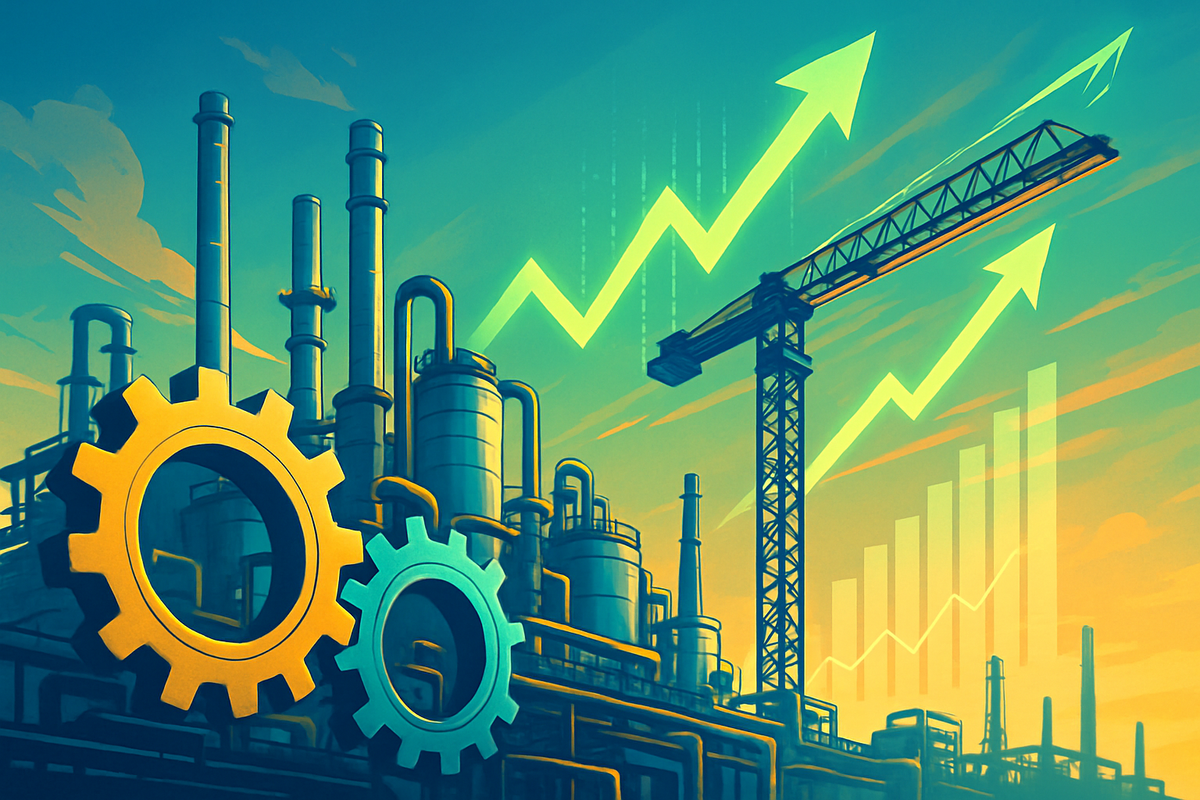
October 3, 2025 – The U.S. stock market witnessed a powerful surge today, with the Industrials sector leading the charge, propelling both the Dow Jones Industrial Average (DJIA) and the S&P 500 (SPX) to unprecedented record highs. This robust performance is being heralded as a strong indicator of underlying economic health and renewed corporate confidence, sending a wave of optimism across global financial markets. The significant uplift from industrial giants underscores a broadening market rally, suggesting that economic expansion is gaining considerable traction.
The day's trading saw investors flocking to companies involved in manufacturing, infrastructure, aerospace, and transportation, sectors traditionally seen as bellwethers for economic cycles. This decisive move by the Industrials sector not only contributed substantial points to the benchmark indices but also solidified the narrative of a resilient economy poised for continued growth. Market analysts are keenly observing this cyclical leadership, interpreting it as a clear signal of an economy transitioning into a more mature and sustainable expansion phase.
A Day of Historic Gains: What Fueled the Industrial Surge
Today's exceptional performance in the Industrials sector was a culmination of several factors, signaling a robust economic environment. The sector's ascent began early in the trading session, with strong buying interest evident across a broad spectrum of industrial companies. Key drivers included better-than-expected manufacturing Purchasing Managers' Index (PMI) data released earlier in the week, which indicated expanding factory orders and production. Additionally, recent government announcements regarding accelerated infrastructure spending initiatives provided a significant tailwind, promising increased demand for construction, engineering, and materials.
The timeline leading up to this moment reflects a steady improvement in economic fundamentals throughout late 2024 and 2025. Supply chain bottlenecks, a persistent concern in previous years, have largely eased, allowing industrial companies to ramp up production and fulfill backlogs more efficiently. Furthermore, a stable interest rate environment, coupled with declining commodity prices in recent months, has lowered operational costs and boosted profit margins for many industrial players. This confluence of positive economic indicators created fertile ground for today's breakout performance.
Key players such as Boeing (NYSE: BA), Caterpillar (NYSE: CAT), and General Electric (NYSE: GE) saw significant gains, with their stock prices climbing notably throughout the day. These industrial behemoths, representing diverse sub-sectors from aerospace and heavy machinery to power and renewable energy, are often seen as proxies for global economic activity. Their strong showing today suggests widespread confidence in both domestic and international economic recovery and growth prospects.
Initial market reactions have been overwhelmingly positive, with analysts swiftly upgrading their outlooks for the sector. Investment banks are highlighting the sector's attractive valuations and strong earnings potential, suggesting that the rally may have further room to run. While some cautious observers point to potential inflationary pressures from increased demand, the prevailing sentiment is one of exuberance, with many investors viewing the Industrials sector as a leading indicator of a sustained bull market.
Companies Poised to Win and Lose in the Industrial Boom
The robust performance of the Industrials sector is expected to create a clear divide between potential winners and those who may struggle to keep pace. Companies deeply entrenched in infrastructure development, advanced manufacturing, and defense are particularly well-positioned to capitalize on the current momentum. For instance, companies like Deere & Company (NYSE: DE), a leading manufacturer of agricultural and construction equipment, are set to benefit immensely from increased global construction projects and agricultural demand, bolstering their revenue streams and market share. Similarly, defense contractors such as Lockheed Martin (NYSE: LMT) and Raytheon Technologies (NYSE: RTX) could see sustained growth driven by geopolitical stability concerns and ongoing government contracts.
Aviation and aerospace firms, including industry giants like Boeing (NYSE: BA) and General Electric (NYSE: GE), are also expected to be major beneficiaries. With global travel resuming and airlines looking to modernize their fleets, demand for new aircraft and aviation services is projected to soar. GE's diversified portfolio, encompassing aviation, power, and renewable energy, positions it uniquely to leverage both industrial expansion and the global transition towards sustainable energy solutions. These companies, with their extensive global footprints and strong order backlogs, are likely to report robust earnings in the coming quarters, driving further investor interest.
Conversely, companies with heavy exposure to legacy manufacturing processes, high energy consumption, or those struggling with labor shortages might face challenges. While the overall sector is thriving, firms that have been slow to adopt automation, sustainable practices, or digital transformation initiatives could find themselves at a competitive disadvantage. Smaller, less diversified industrial players might also struggle to compete with the scale and technological advancements of their larger counterparts, potentially leading to market share erosion or consolidation within the sector. The increased demand could also strain supply chains for some, leading to higher input costs if not managed effectively.
Wider Significance: A Bellwether for Broad Economic Health
The surge in the Industrials sector carries wider significance, serving as a powerful bellwether for the broader economic landscape. This event fits squarely into broader industry trends emphasizing reshoring of manufacturing, significant investments in infrastructure upgrades, and the ongoing energy transition. Governments worldwide are prioritizing resilient supply chains and modernizing aging infrastructure, directly benefiting industrial companies involved in construction, engineering, and capital goods production. The focus on renewable energy and sustainable technologies also provides a long-term growth runway for industrial firms innovating in these areas.
The ripple effects of this industrial boom are expected to extend across various sectors. Increased industrial activity will naturally boost demand for raw materials, benefiting the Basic Materials sector. Enhanced manufacturing and trade will also positively impact the Transportation and Logistics sector, as goods need to be moved efficiently. Competitors within the Industrials sector will likely face intensified competition, spurring further innovation and efficiency gains, while partners in supply chains will see increased business opportunities. The robust performance signals a healthy corporate spending environment, which could spill over into technology investments and employment growth.
From a regulatory and policy perspective, the strong industrial performance could reinforce government commitments to infrastructure spending and supportive trade policies. It might also lead to renewed focus on vocational training and STEM education to meet the growing demand for skilled labor in manufacturing and engineering. Historically, strong industrial sector performance has often preceded periods of sustained economic expansion. Comparing this to similar growth spurts in post-recessionary periods, the current rally suggests a fundamental strengthening of the economy rather than a speculative bubble, underpinned by tangible demand and production. This signals a shift from purely financial market-driven growth to one rooted in real economic activity.
What Comes Next: Navigating Opportunities and Challenges
Looking ahead, the robust performance of the Industrials sector on October 3, 2025, sets the stage for both short-term momentum and long-term strategic shifts. In the short term, investors can expect continued positive sentiment, potentially leading to further capital inflows into industrial stocks. Companies within the sector are likely to see increased order backlogs, improved revenue visibility, and stronger earnings reports in the upcoming quarters. This could translate into dividend increases and share buybacks, further enhancing shareholder value. However, vigilance will be required to monitor for any signs of overheating, such as rapid increases in commodity prices or labor costs that could erode profit margins.
For the long term, the industrial boom necessitates strategic pivots and adaptations. Companies will need to continue investing heavily in automation, digital transformation, and sustainable technologies to maintain their competitive edge and meet evolving market demands. The emphasis on resilient supply chains will likely drive further domestic production and nearshoring initiatives, reshaping global manufacturing footprints. Market opportunities will emerge in areas like smart factories, industrial IoT, and green infrastructure, prompting companies to innovate and potentially acquire smaller, specialized firms to bolster their capabilities.
Potential scenarios and outcomes include a sustained period of economic expansion driven by industrial growth, leading to a broader bull market across cyclical sectors. Alternatively, unforeseen geopolitical events or a sudden shift in monetary policy could introduce headwinds, requiring industrial firms to demonstrate agility and robust risk management strategies. However, the current trajectory suggests that the sector is well-positioned to navigate these challenges, with a focus on efficiency, innovation, and strategic capital allocation being paramount for sustained success.
Comprehensive Wrap-Up: A Resilient Economy Takes Flight
Today's exceptional performance by the Industrials sector, driving the Dow and S&P 500 to record highs, marks a significant milestone for the U.S. economy. The key takeaway is clear: the underlying economic fundamentals are strong, and corporate confidence is high. This surge is not merely a fleeting market anomaly but rather a reflection of tangible improvements in manufacturing, infrastructure investment, and global demand. The sector's leadership signals a broadening of the market rally beyond technology and growth stocks, indicating a more balanced and resilient economic expansion.
Moving forward, the market is poised for continued optimism, albeit with an eye on potential inflationary pressures and supply chain dynamics. Investors should assess the long-term growth prospects of individual industrial companies, favoring those with strong balance sheets, innovative product pipelines, and a clear strategy for leveraging emerging trends like automation and sustainability. The emphasis on real economic activity and corporate profitability suggests a healthier market environment compared to periods driven purely by speculative fervor.
Final thoughts on the significance and lasting impact point to a potential new era of industrial resurgence. This isn't just about recovering from past downturns; it's about building a more robust, technologically advanced, and environmentally conscious industrial base. What investors should watch for in the coming months includes sustained positive economic data, corporate earnings reports from key industrial players, and further government policy initiatives that support manufacturing and infrastructure. The trajectory set today suggests a promising path for the Industrials sector and, by extension, the broader market.
This content is intended for informational purposes only and is not financial advice






